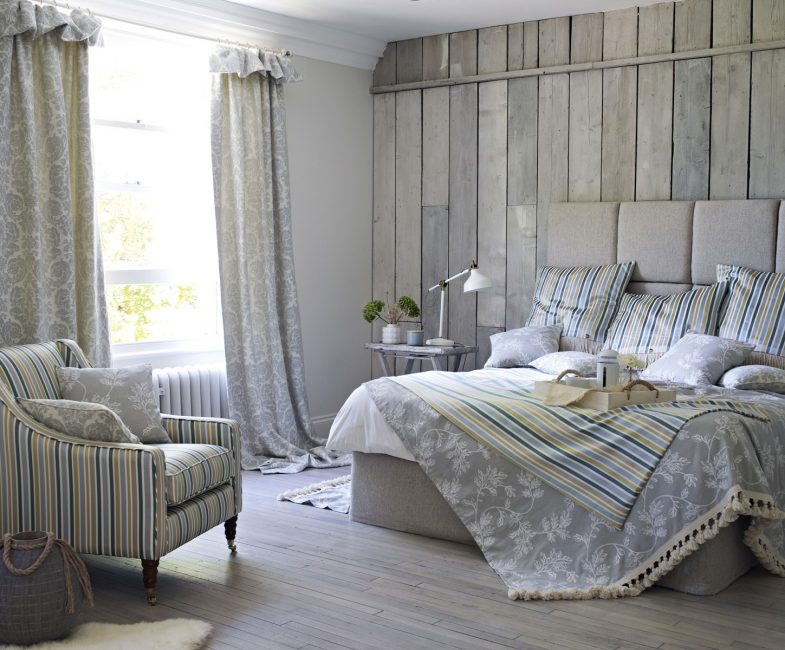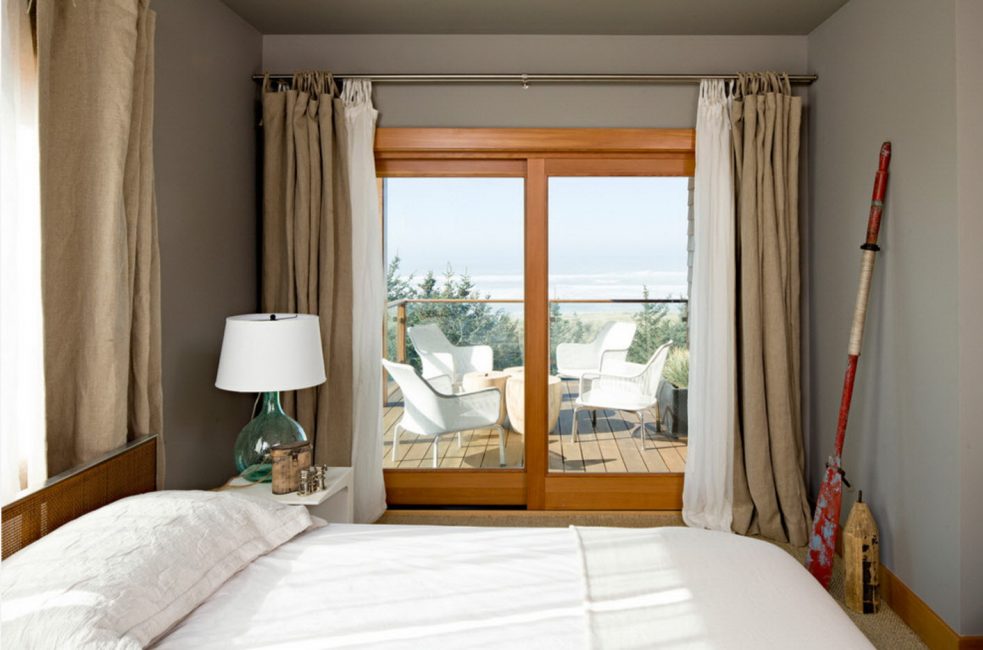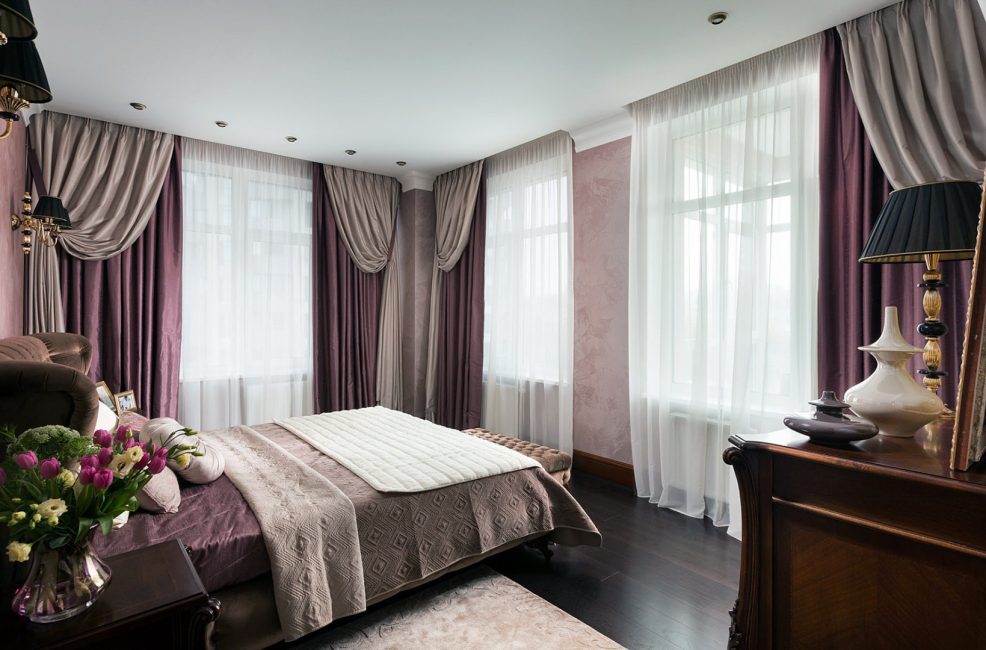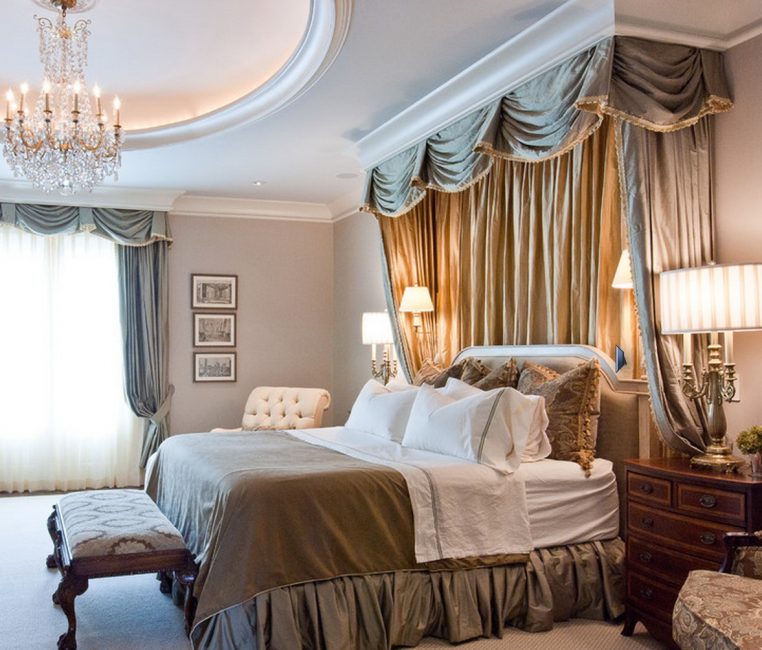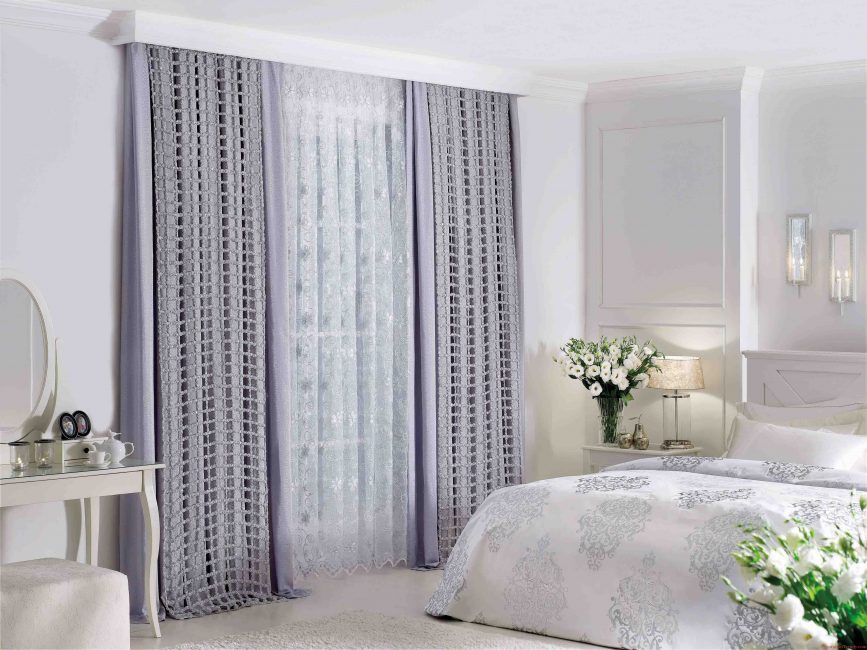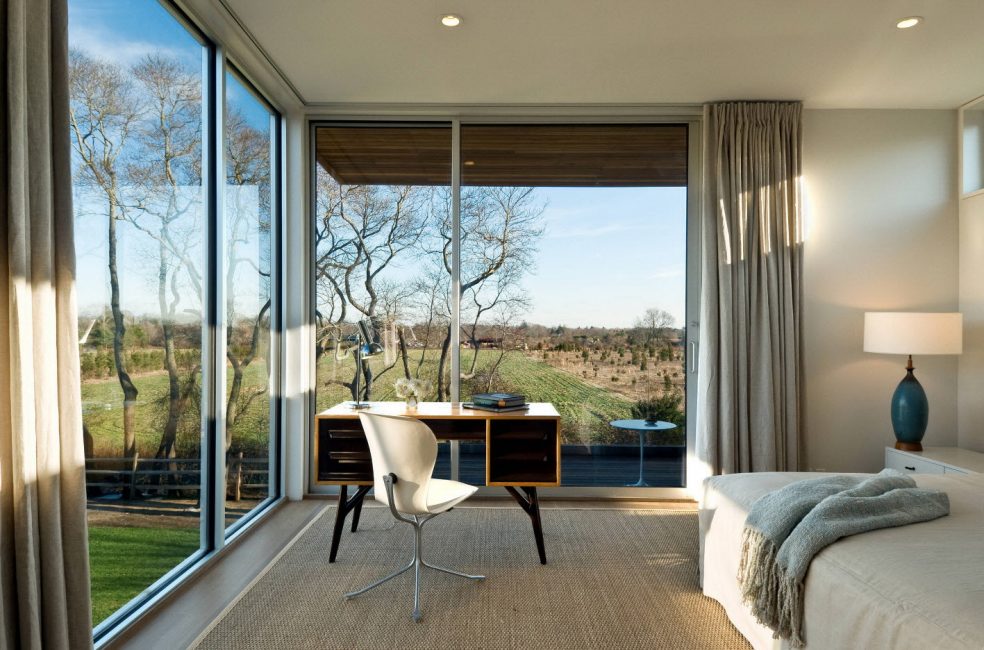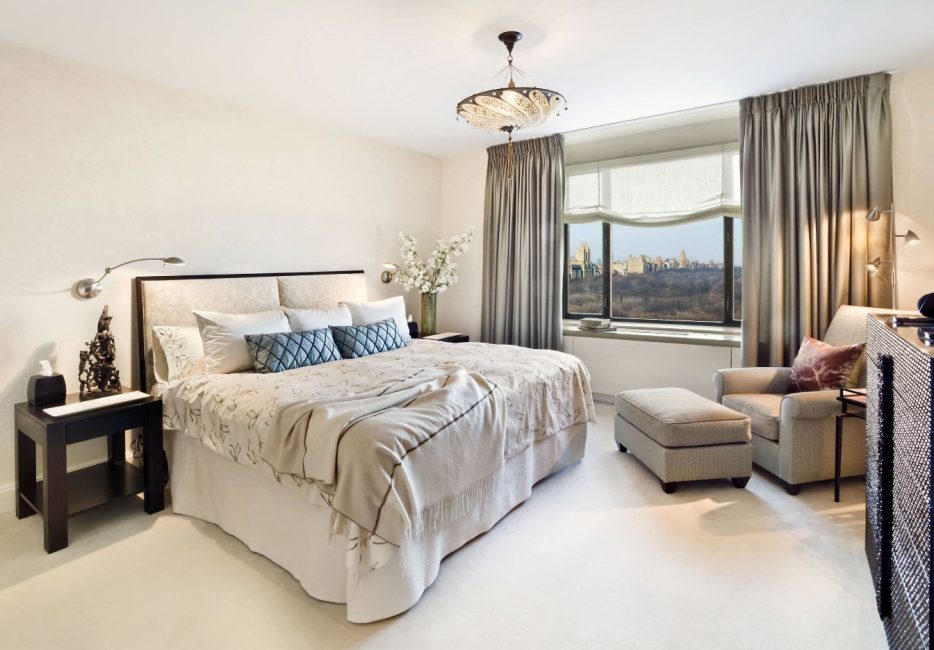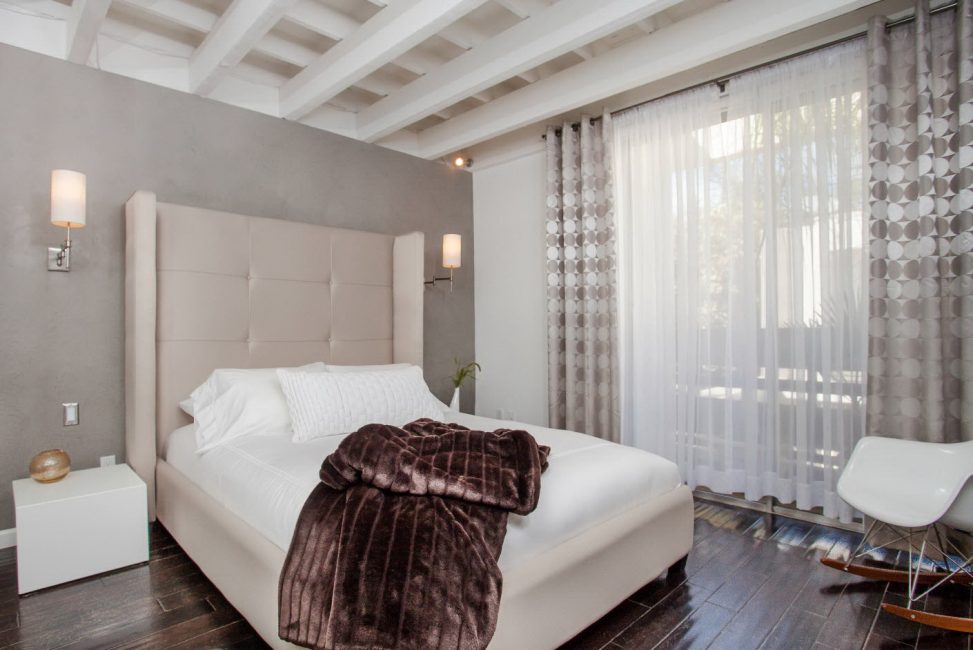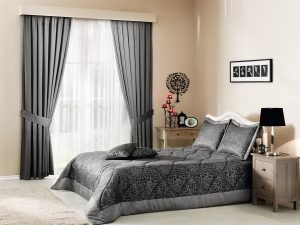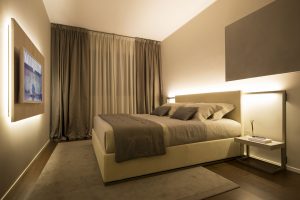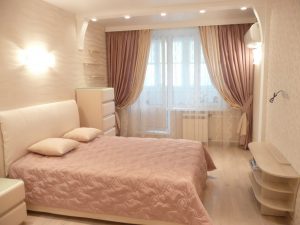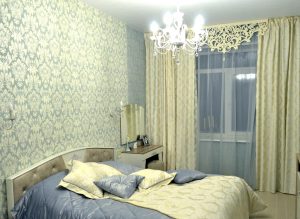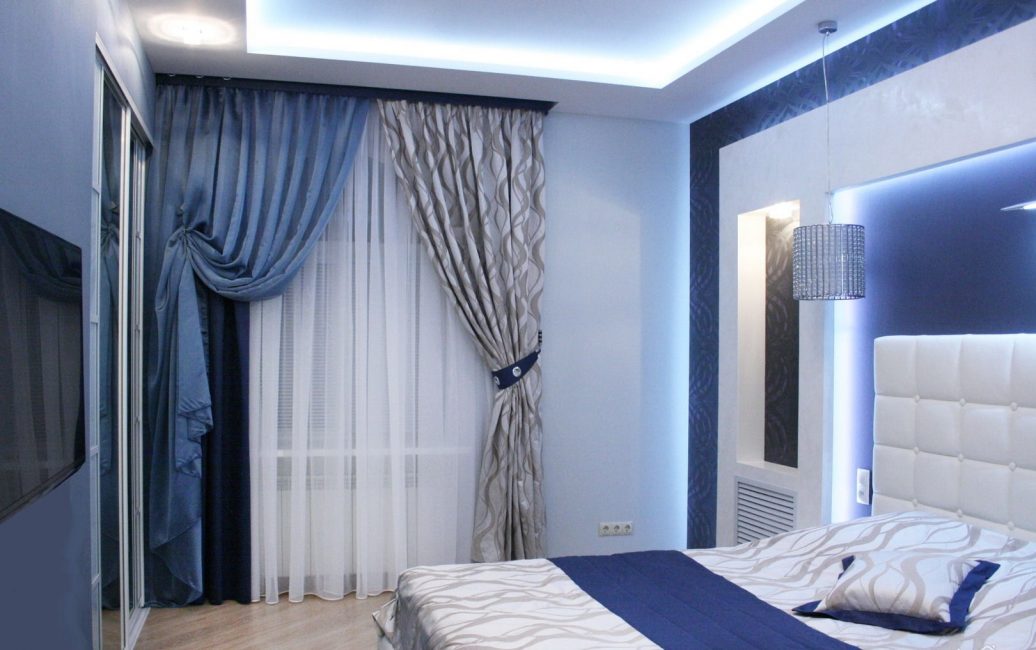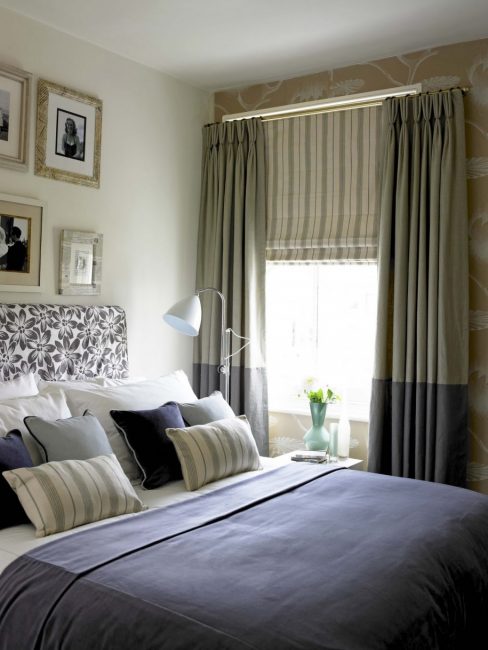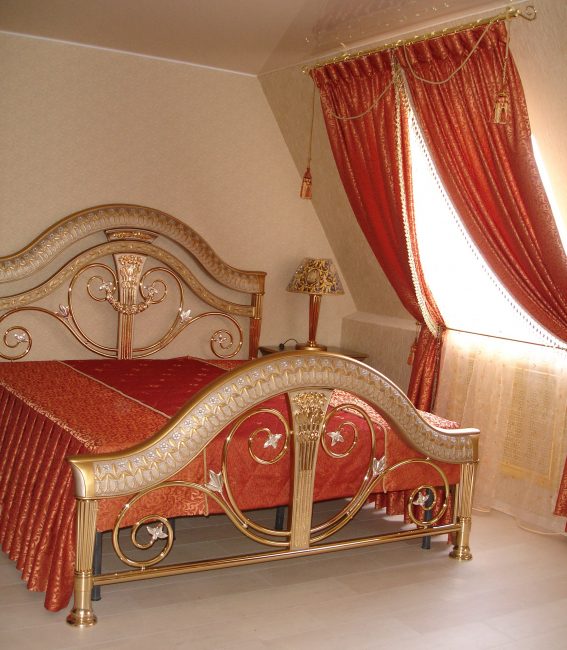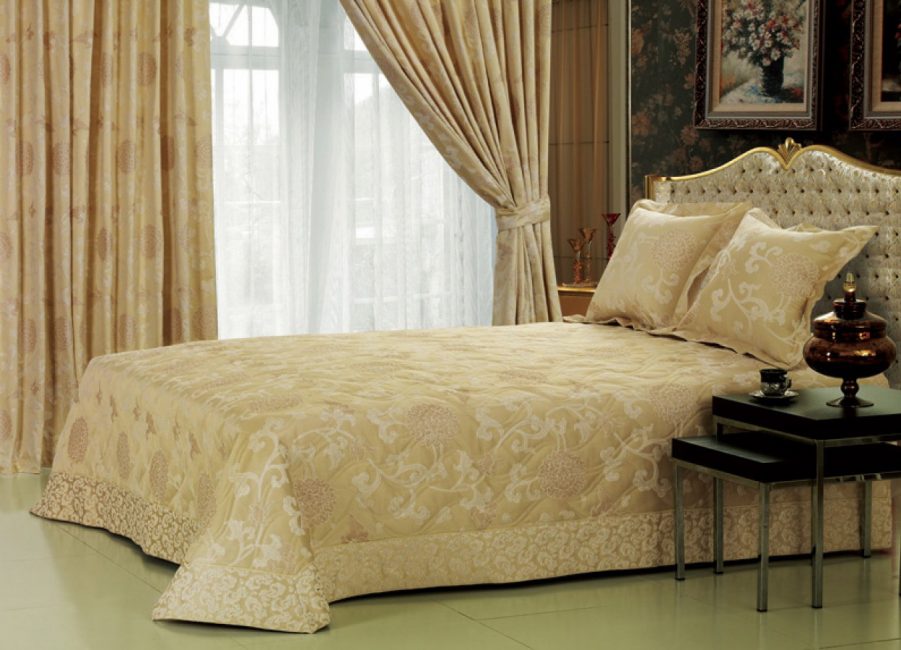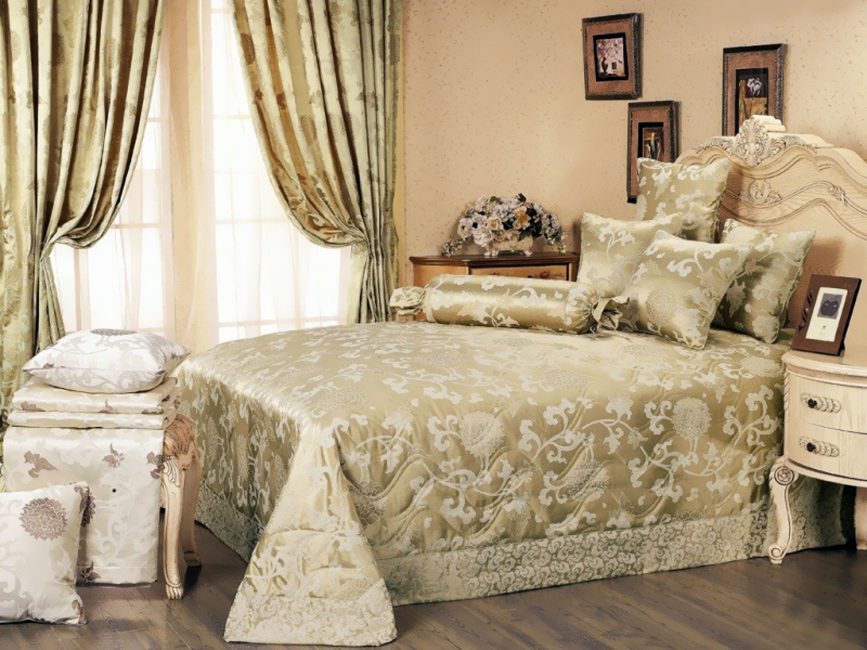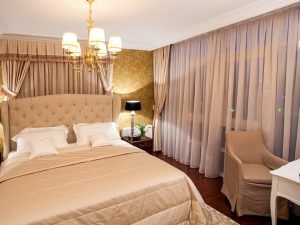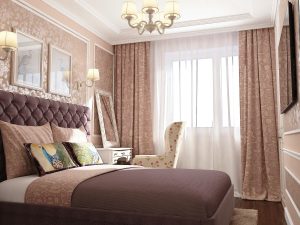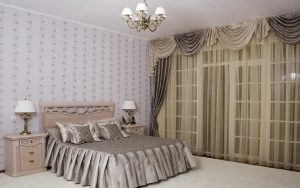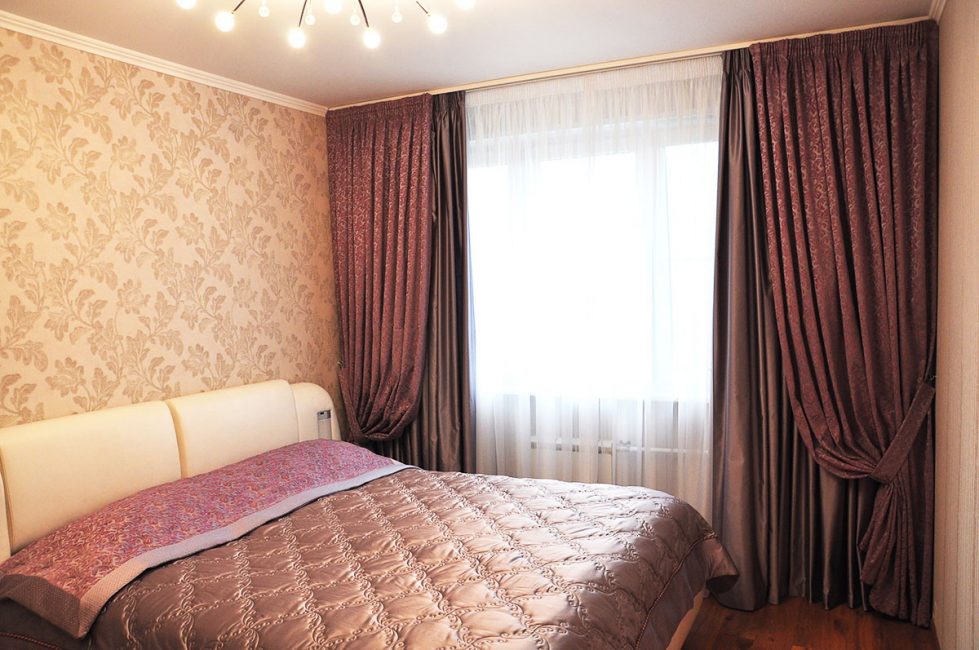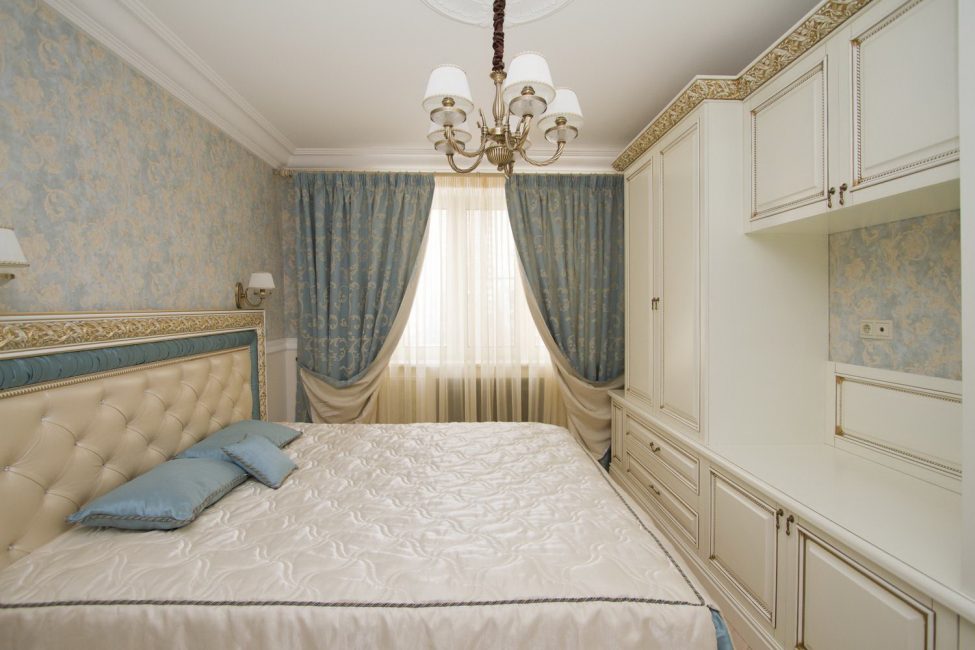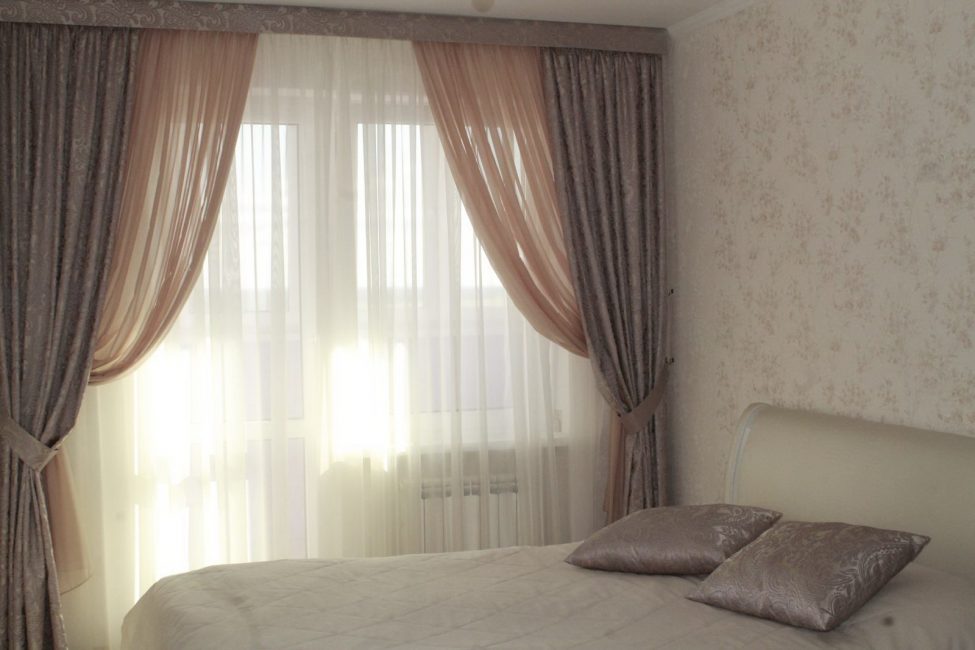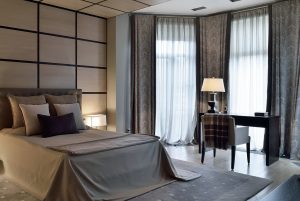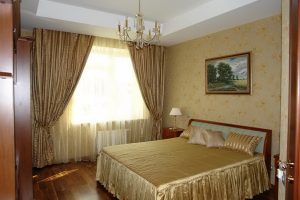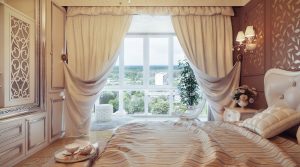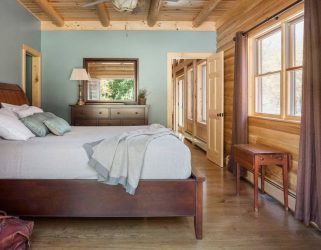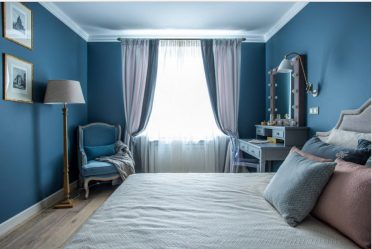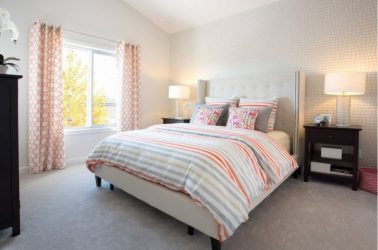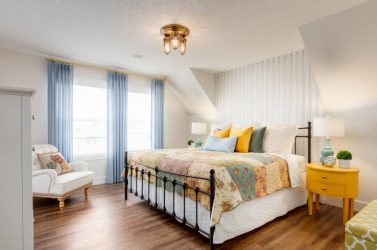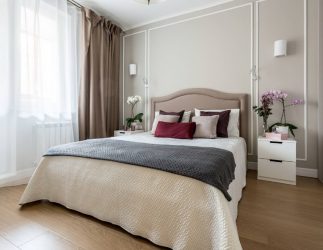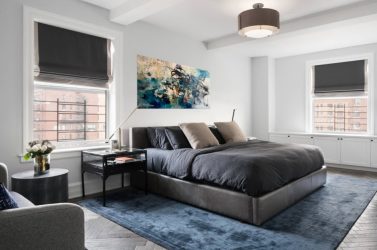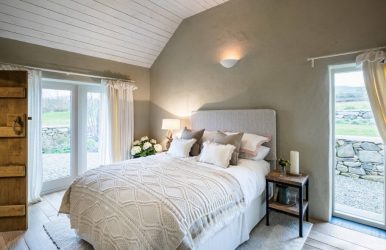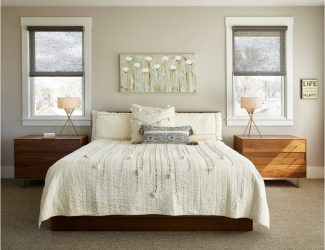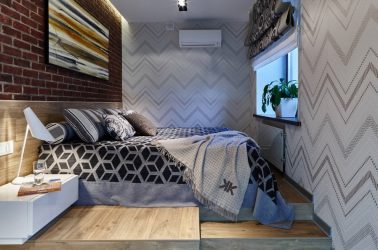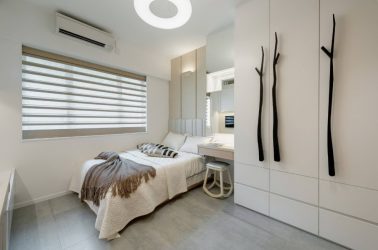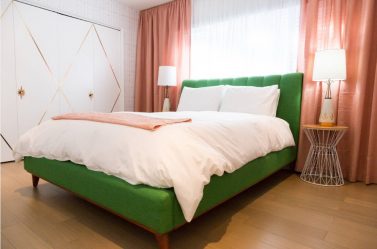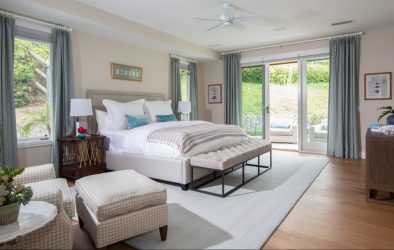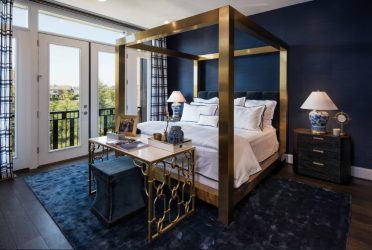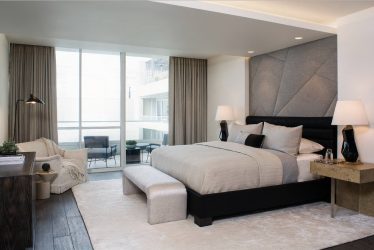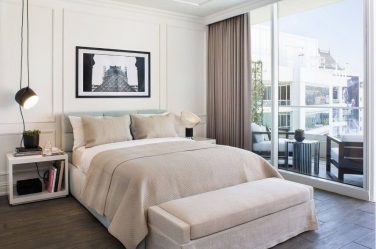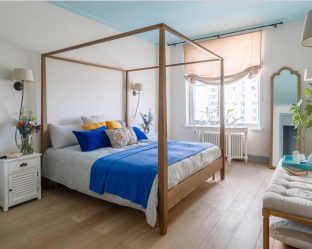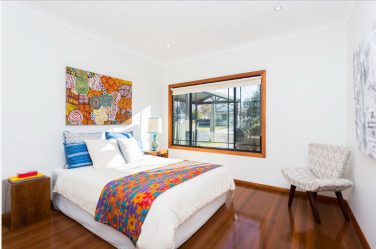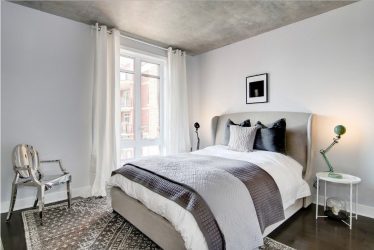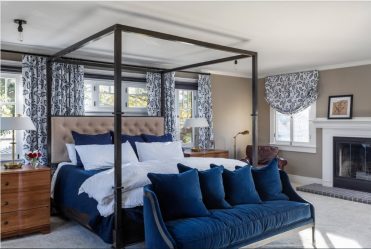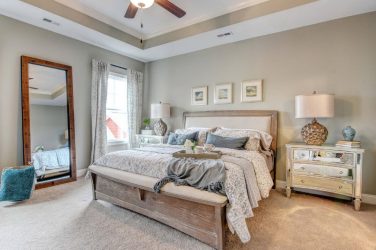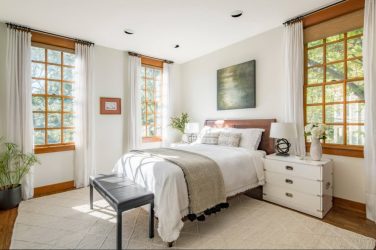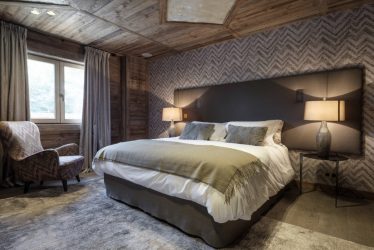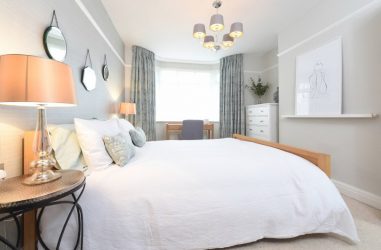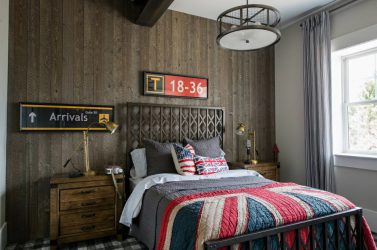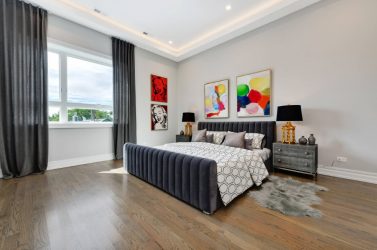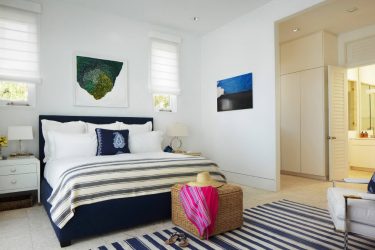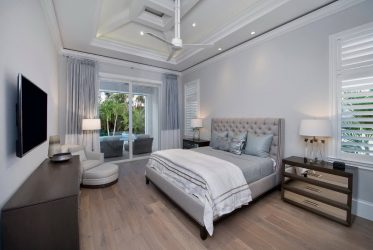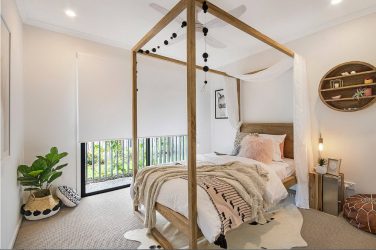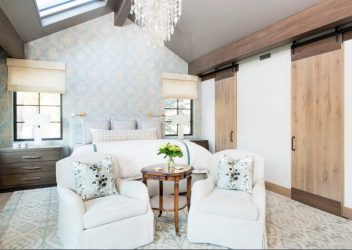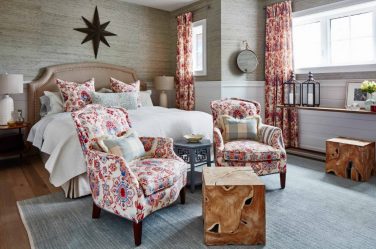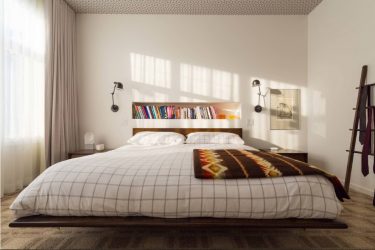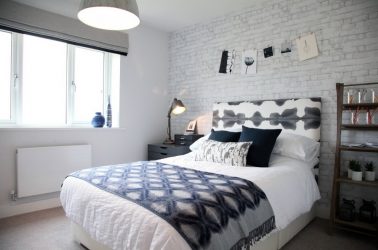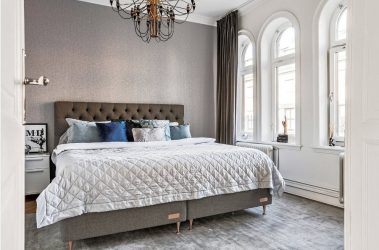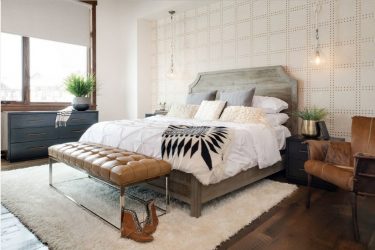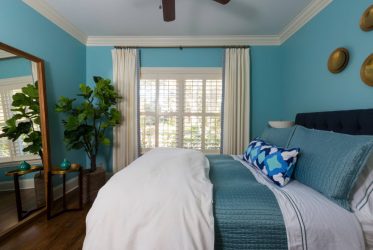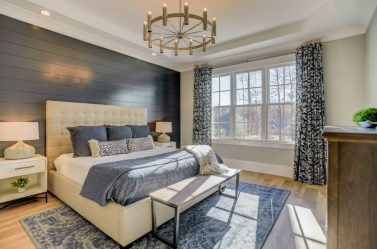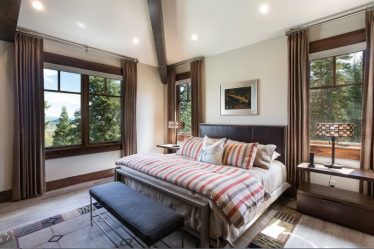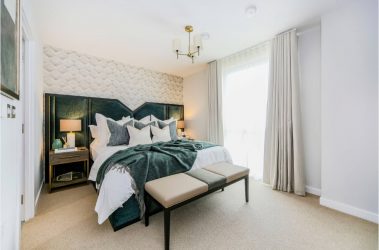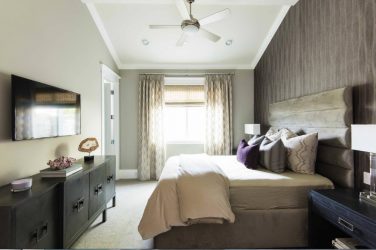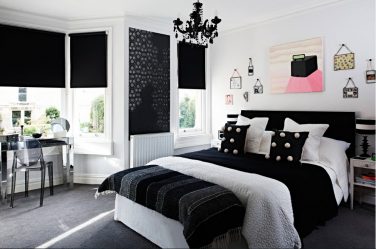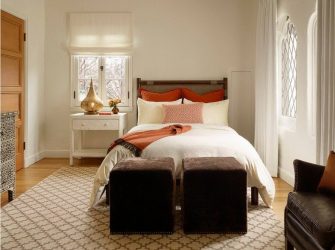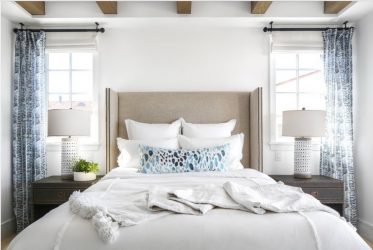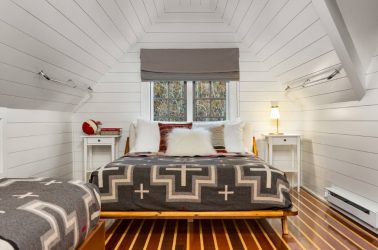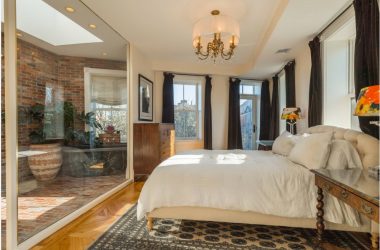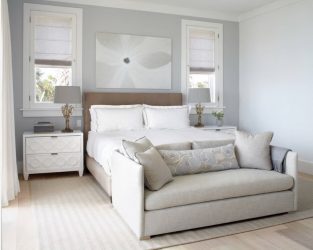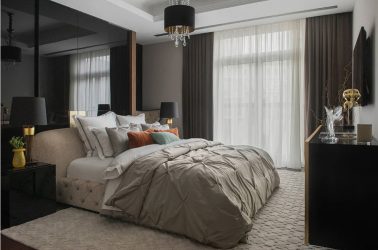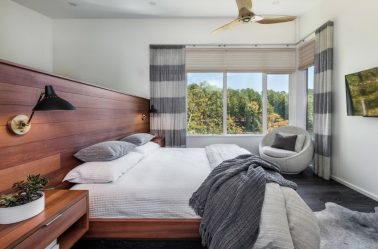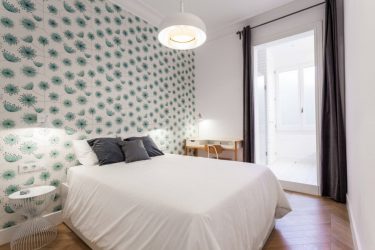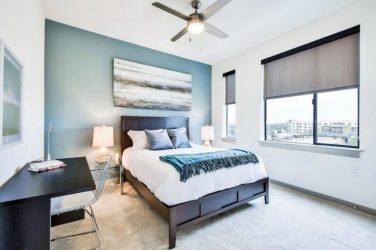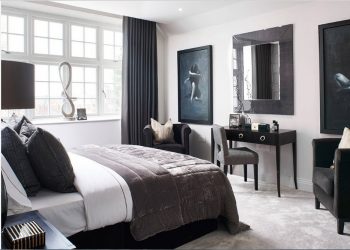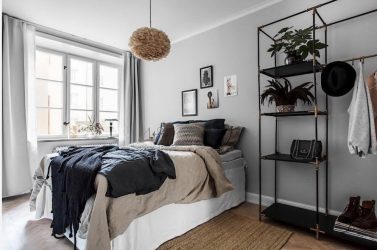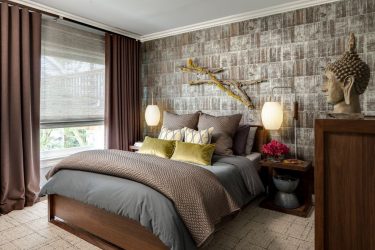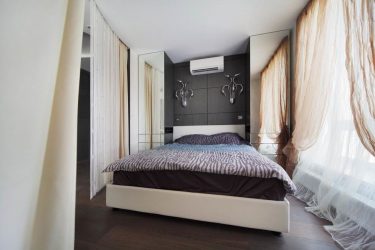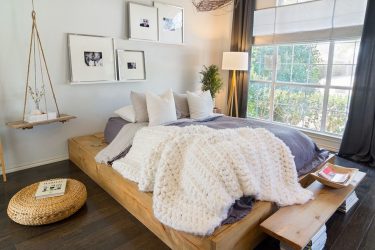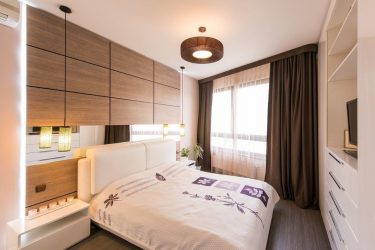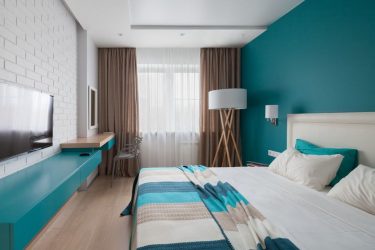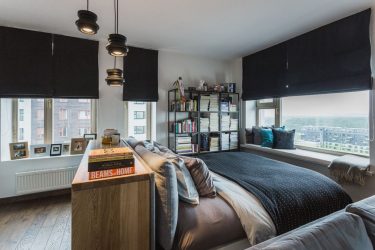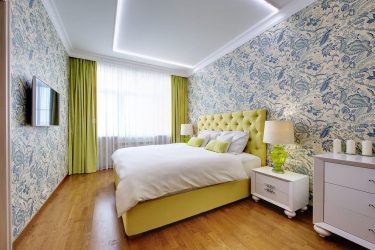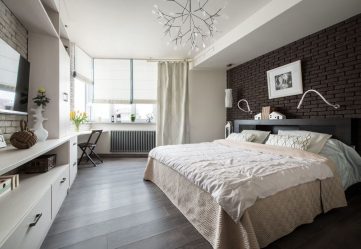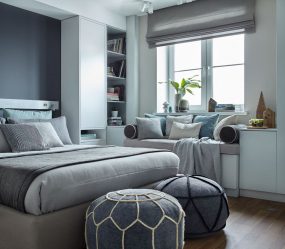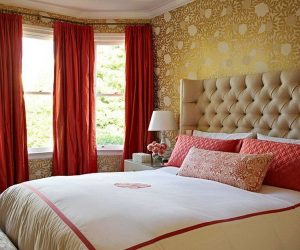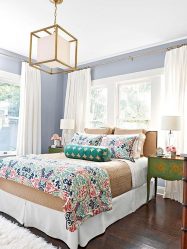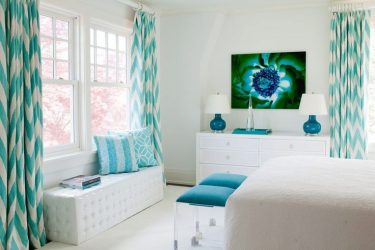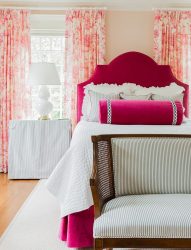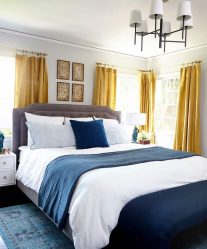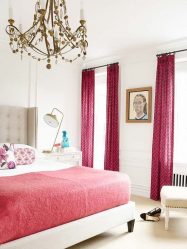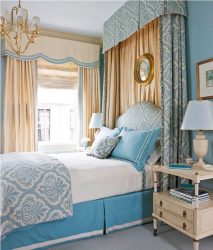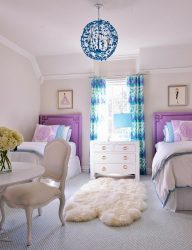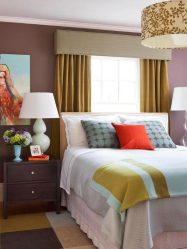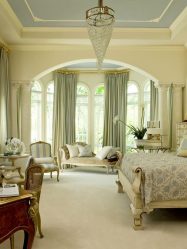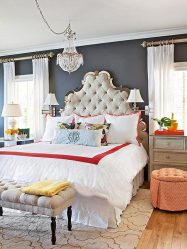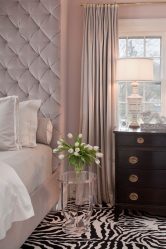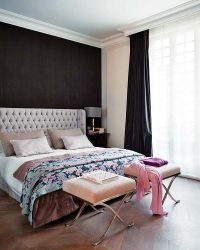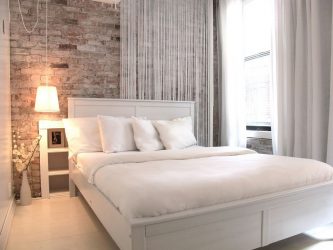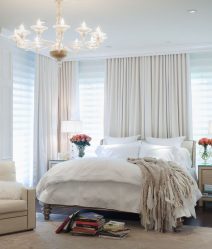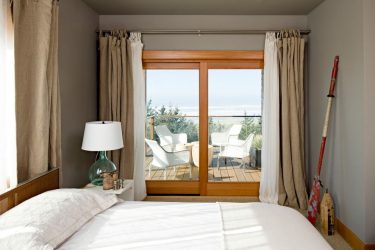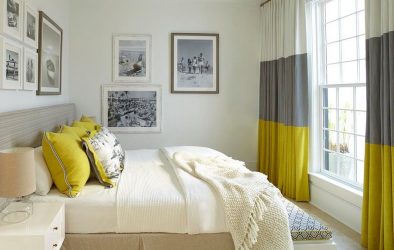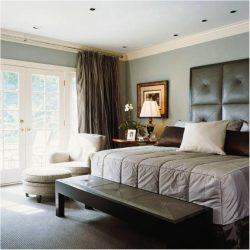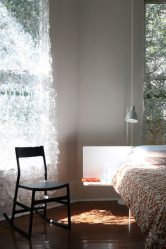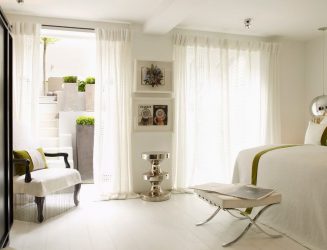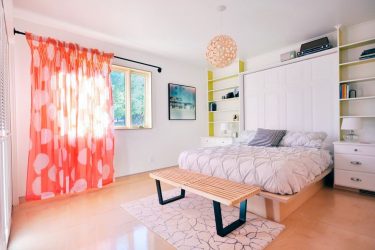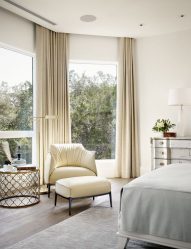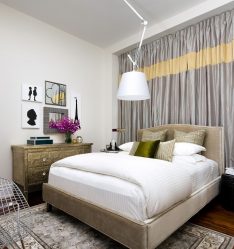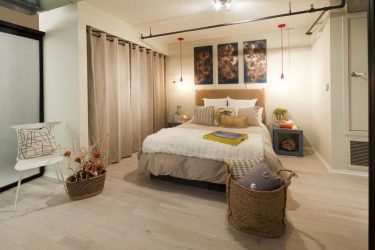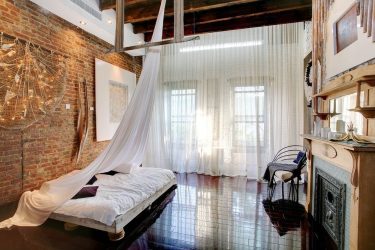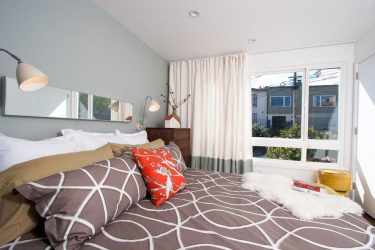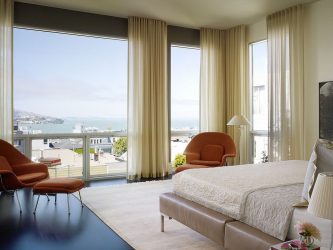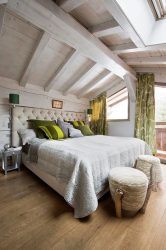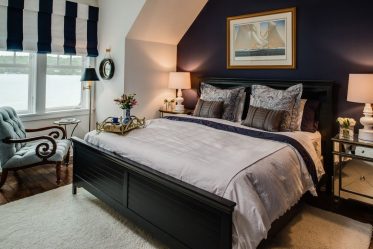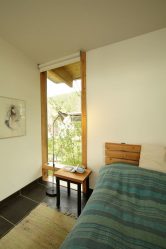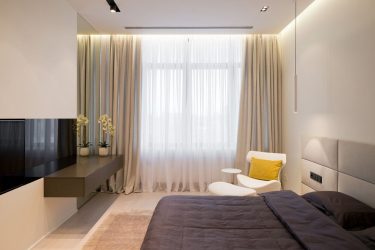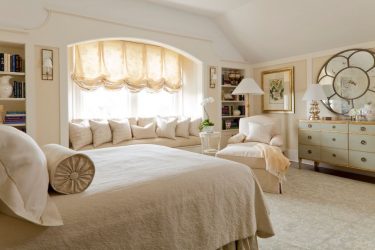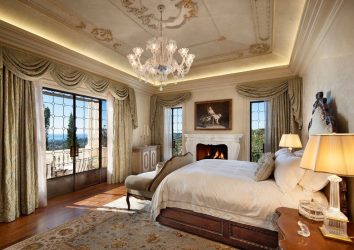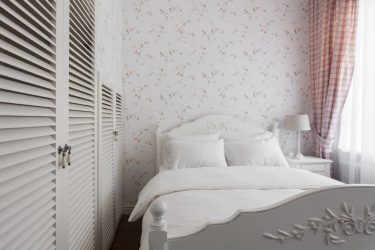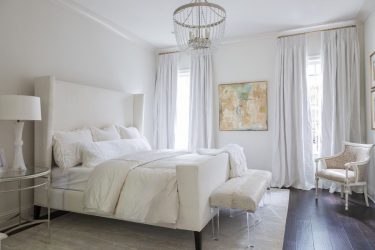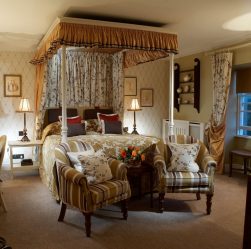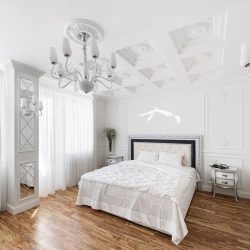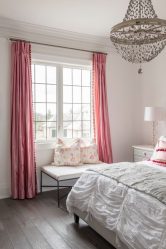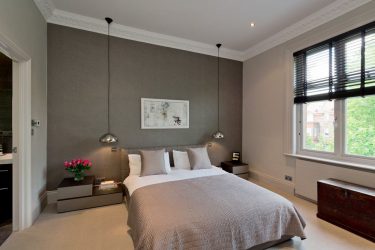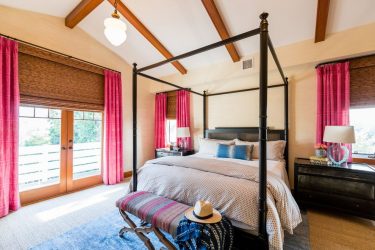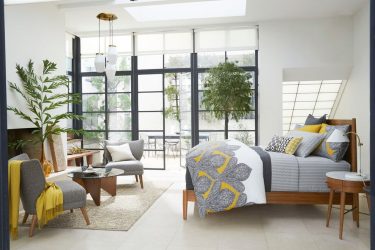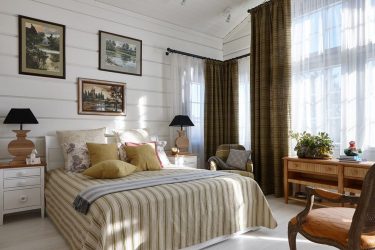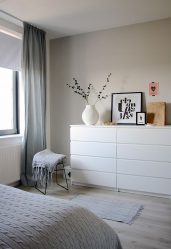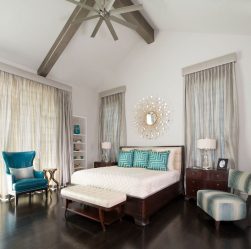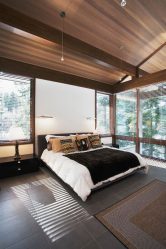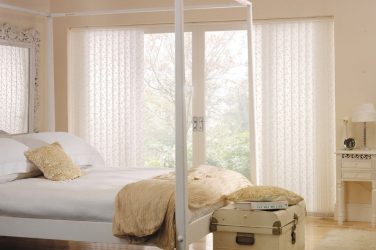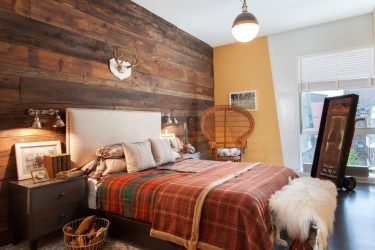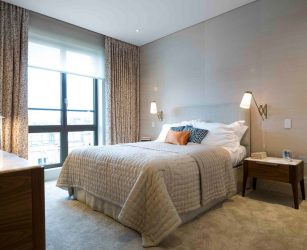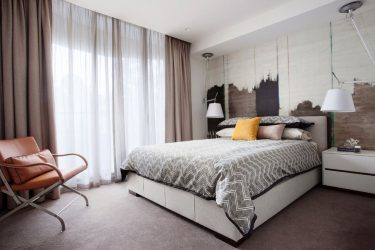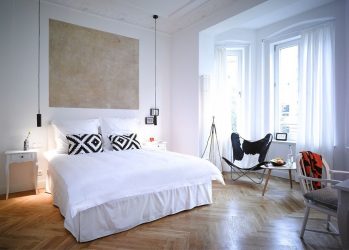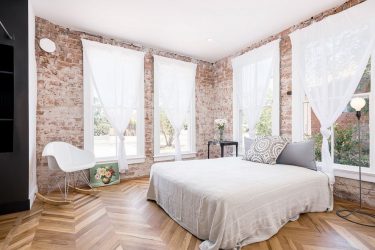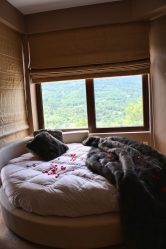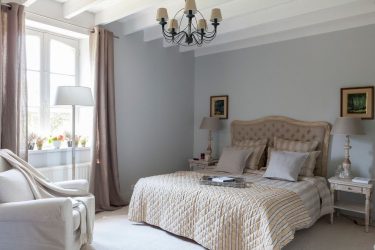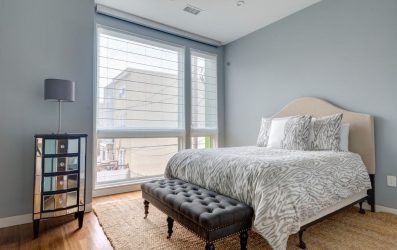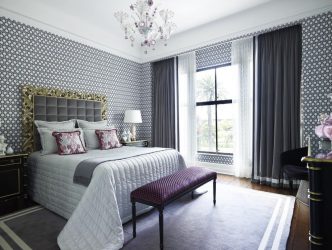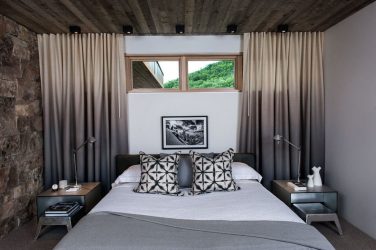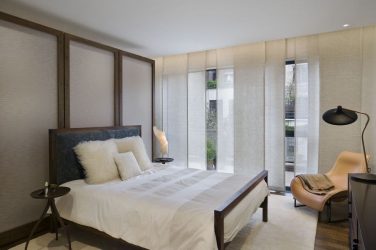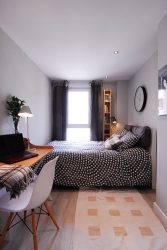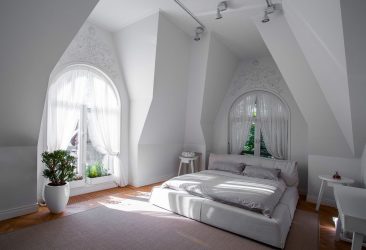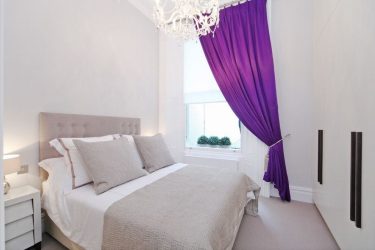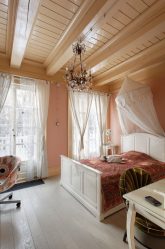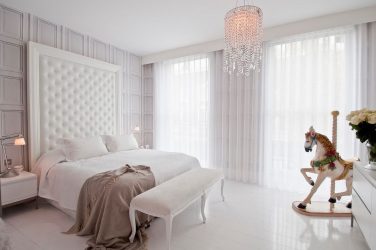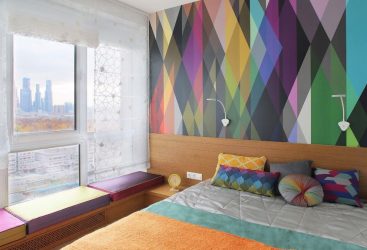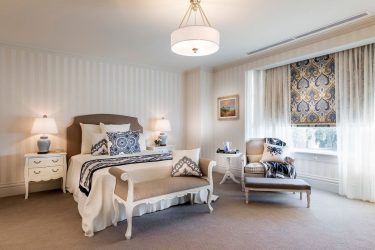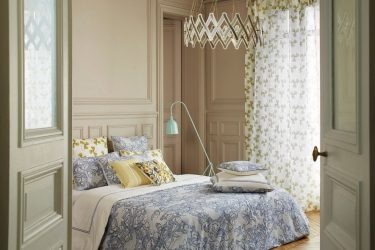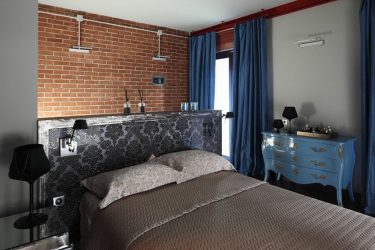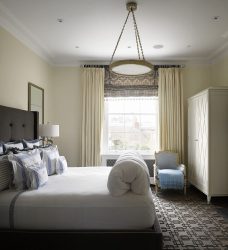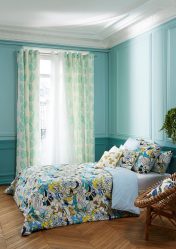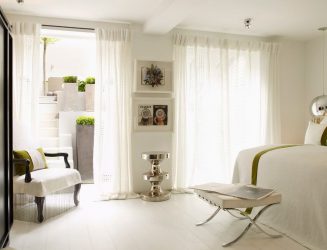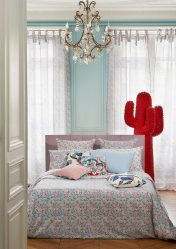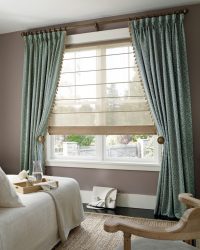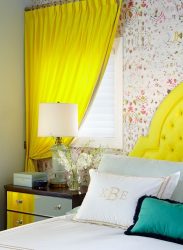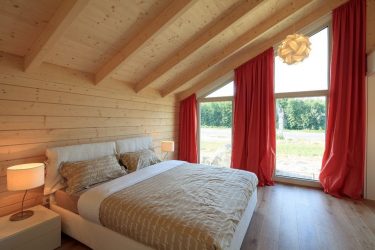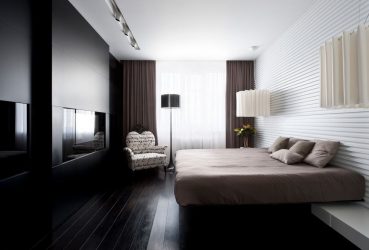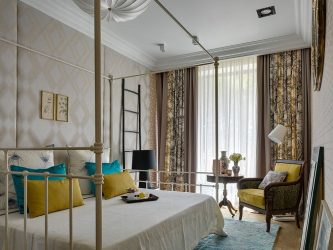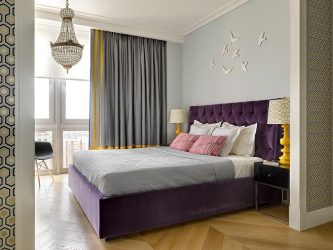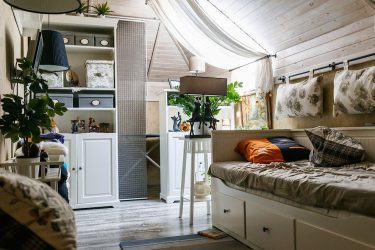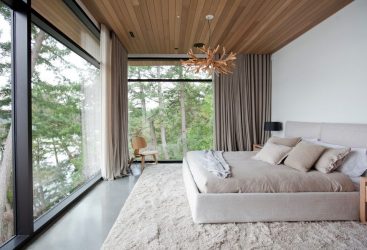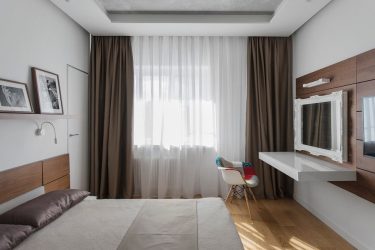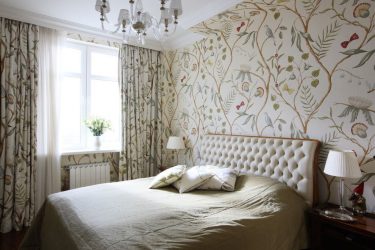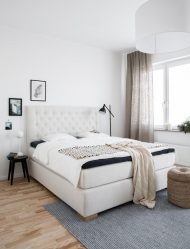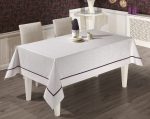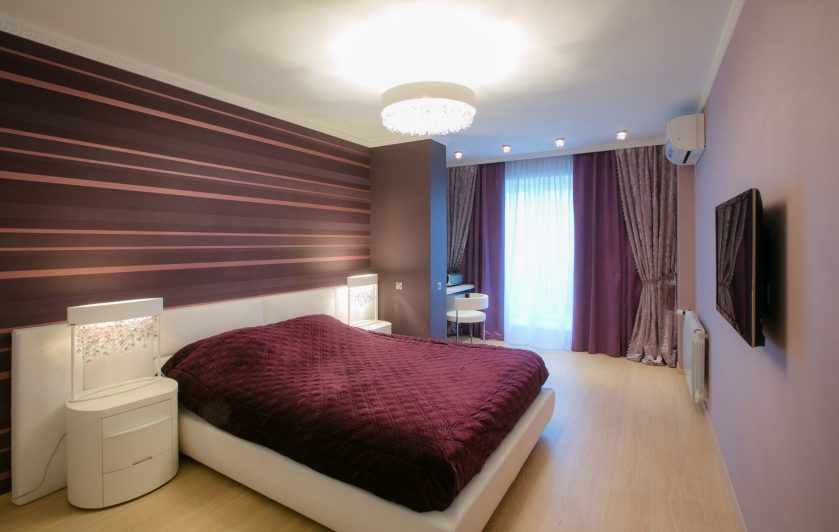
Curtains for the bedroom is difficult to pick up. Before you make a choice in favor of one type or another, learn all the nuances and recommendations. After all, curtains should emphasize the chosen style, and not harm. This is a bright accent of your room, which is important to choose the right.
Content:
It is necessary to take into account not only aesthetic delights, but also purely practical aspects. For example:
- curtains for the bedroom should be dark, dense - it has long been proven that a person sleeping in total darkness gets enough sleep, less prone to stress;
- should provide sound insulation - sleeping in silence is more useful than with noise;
- provide insulation - especially if the windows are old, with cracks.
Combine practice with aesthetics, pick up curtains, as an element of a specific interior, but so that they are comfortable - the task is not trivial. To solve it, you need to know what a lambrequin, a bell, lifting, sliding, stationary structures are, what fabric it is best to sew, how to organically include them in the design of the room.
In this we will understand together.
Part One: Components
The design of the curtains can be much more complicated than the usual "several rings, two pieces of fabric." It is in itself - a way to express an idea, to give a bedroom refinement, to turn to a certain style.
return to menu ↑Canvas and Pickups
The canvas in any curtain is of three types:
- curtains for the bedroom should be dark, dense - it has long been proven that a person sleeping in total darkness gets enough sleep, less prone to stress;
- should provide sound insulation - sleeping in silence is more useful than with noise;
- provide insulation - especially if the windows are old, with cracks.
- Roll. Roll came from Asia, meet the usual minimalist style. Dense thin fabric when opened opens up into a roll at the top, and when opened, unwinds back.
Curtains and portieres are the most common and provide a huge scope for creativity. They can be used alone, can be combined (this is done most often).
There are also three ways to decorate them:
- Curtains with curtains can freely hang to the floor. Either the fabric is straight, smoothed, or there are artistic pictorial folds.
- You can use grab. Lace, wide ribbon, fluffy brush, wooden or metal ring, velcro - hooks are the most diverse and can be attached at different heights. Their main function is practical - to keep curtains with curtains at the edges of the window.Additionally, there is also aesthetic - pickup often becomes an accessory that is designed to complement the overall composition. Interestingly, the color of it can both coincide with the main color, and be contrast - the effect is easy to imagine.
- You can use the puff. It is believed that this word came from France, its original meaning is “emptiness”. When applied to curtains, it is a way to give the fabric bulkiness. The canvas is hung up to the eaves, after or in a special way it is sutured, or intercepted by a cord so that as a result the fabric reaches a specific height, creates a volumetric puff there, and then freely falls off further. Recommended for bedrooms with high ceilings.
The combination of only two elements can give the curtains a certain personality. Further, adding more and more details, you will be able to make such a design that fits to your bedroom.
return to menu ↑Attachment methods and pelmet
It would seem that there is nothing easier than to fix the curtains on the eaves - and yet, this is an important design nuance that affects the overall impression of the room. There are:
- On the rings. A common option that can be seen in most classic interiors. The rings can be wooden or metal, the fabric is attached to them with hooks. The main advantage of the design is that it slides easily, and if you pull the fabric, the hook will come off the ring, there will be no more serious damage.
- On grommets. Cringles are the same rings, only they are embedded directly inside the canvas. Gliding is just as good, but if you pull it, it will break from the eaves, most likely by damaging the fabric. They come in different sizes, sometimes, for a more interesting effect, they are made in a contrasting color with respect to the fabric. Their main advantage is that the canvas hanging from them lies in beautiful even folds.
- On ties. Holes are made in the curtains, laces or ribbons are passed through them, and then carefully tied at the eaves. They are easy to change, if you get tired, you can dream up on the topic of knots, bows, brushes. The method is suitable for a light, airy fabric - as a result, the curtain looks absolutely weightless, romantic.
- Hinged. The loops are sewn into the top of the canvas (or attached to it with velcro), put on the eaves. They may have different widths, color may differ from the main one. They will add coziness to the bedroom, they are well suited for a nursery - if the child pulls the hanging edge, the loop on the velcro will simply open, there will be no damage.
- On the drawstring. In the upper part of the curtains, a special pocket is made into which the cornice is inserted - the fabric itself is assembled at the top with dense small folds. The main advantage is noiselessness (there is a plus for both loops and ties).
No squeaking metal - only pleasantly rustling fabric.
To complement the upper part of the curtains in cases where the loops, the drawstring, the strings are too lightly, and the grommets and rings are too boring, will help pelmet. It represents the upper horizontal element of the curtains - a cut of fabric that hangs from the eaves and closes the fastening method. May be the same color as the rest of the canvas, may be contrasted.
A clear smooth edge or fancy waves - you need to look for relevance.
Lambrequins are:
- Bando. Hard lambrequin, which is impossible to put fancy folds and which makes the window more visually, if you place it over the eaves, or wider, if you make it wider than the window.
- Swag. Soft lambrequin, which lies in beautiful folds, the edges while hanging freely. The solution for the classic interior - but for all modern styles hopelessly outdated.
- Perekid. Also a soft lambrequin, which spreads over the eaves in one or two places, the edges sag freely.
Ruffles can complement the composition with lambrequins. Light, airy fabric, a thin section of which is attached to the edges of the main structure - as a result, they seem softer, less formal. Of course, ruffles are not combined with heavy fabric.
Part two: styles and principles of opening
The curtains are different - they can be divided into three large groups, the first of which is sliding curtains.
Among them:
- Classic straight. It can be seen in most houses - the window closes the tulle, on the sides hang thick curtains that close at night. Something more simple to think hard, suitable for bedrooms in any style.
- Crossed. In fact, the same classic, only the right side of the canvas is suspended from the eaves, and fixed on the left side of the window, while the left is exactly the opposite. This is a way to slightly diversify the boring design of the classics, to make it a little more bold, extravagant.
- Cafe. This is an interesting option that should be used for the bedroom, only if the rising sun does not look into it in the morning. The fact is that in this case the cornice is fastened to the middle of the window, not from above, and as a result, the part that remains open always receives light. Top construction complements lambrequin, the bottom edge of the curtains comes only to the window sill.
Well, such curtains look, if they are made of light colorful fabric, decorated with buttons, bows, ruches - emphasize the lightheadedness inherent in the design itself.
- Japanese. Such curtains are made of rigid canvas, most often with an admixture of plastic - it is mounted on a frame that runs along the top of the window, if a person needs to change his position, he pushes the canvas aside, like a sliding door. This is original, in Russia you will rarely see this. Especially well suited for a minimalist style with a Japanese slant - in this case it would be a good idea to order a canvas that looks like paper and paint it manually.
- Kisey. In this case, thin heavy threads are used, which constitute a curtain - they work as a curtain replacement. Can be used on their own, in combination with heavy curtains. The main plus - airiness, lightness. Kisey is best suited for a light, warm design with an emphasis on the window.
The second group - lifting
They coincide in width with the window, and move apart not to the sides, but rise upwards.
Among them:
- Austrian. Were very popular in the eighteenth century. They represent a continuous canvas, which hangs exactly in the lowered form. But it is necessary to lift it - and bizarre folds are formed, which remain, if you fix the curtain in the upper position. The lighter the fabric of the curtains - the more free, narrow folds are obtained. You can add Austrian curtains with heavy curtains, but more often they act separately, by themselves.
- French. As the name implies, came from France. They are very similar to Austrian ones, but with one minor difference - even in the lowered state, the canvas remains folded, which makes it a more interesting decision. Made of lightweight, airy fabric - this is one of the requirements of style.
- Roman. They were popular during the Roman Empire, similar to the simplest version. jalousie - flat cloth, stitched at regular intervals so that the horizontal planes were formed. Behind the cord is attached, it is worth it to pull - the planks will rise.Allows you to adjust how much light is in the room, since the curtains can be stopped in an intermediate position. There are either the most stringent, straight, or those that retain the folds even in the lowered position.
- English. They are similar in principle to the Roman ones, but they are made of light fabric, the folds are not hard, but soft, whimsically falling. The merits are the same.
- Rolled. As compact as possible, they fit well into the minimalist interior. They represent a dense fabric, which, rising, rolls up into a narrow roll, invisible to the eye. It can be fixed in intermediate positions, maybe with patterns, drawings, or monophonic.
- Pleated. They came from Germany, are similar to the blinds, even more than the Roman. They are made of dense thin fabric, which is collected in the same size horizontal folds. It is worth pulling the lace, fixed on the side - the curtain pulls up to the top of the window, folds. You can stop in an intermediate position, you can decorate the cord with a tassel or a bow, you can buy pleats, not made of fabric, but of paper.
The third group - stationary
They are used infrequently, but in some cases can significantly decorate the interior.
Among them:
- Italian. They look like classic sliding doors, but they won't be able to move them along the eaves - they are fixed on it tightly. To open such curtains, you need to use the pickup. In the morning he is fastened, in the evening he is untied. At the top are constant beautiful folds. Well suited for non-standard windows, where the movement on the eaves is difficult.
- Imperial. Curtains hang down on both sides, on top - lambrequin, which is laid with beautiful folds sagging to the floor. The first sags only a little, the second is hemmed so that it sags lower, the third - even lower. This cascade looks impressive, suitable for a pompous bedroom.
- Bishop Sleeve. Curtains with lush puffs - from one to three or four - really look like a sleeve of a high-ranking ecclesiastic.
- Hourglass. Fixed not from the side of the window, but in the middle. The canvas hangs down; in the middle of it, the lace intercepts, so that its shape resembles an hourglass.
In addition to those that can be hung on the windows, curtains on other places will fit well into the bedroom design:
- In the doorway. Not only acts as a decorative delicacy, but also increases sound insulation. Good fit to open arkam.
- Canopy. A good solution that can fit into any interior - it all depends on what kind of fabric will be used. And the canopy itself provides additional privacy, silence sounds, does not let insects inside, filters light, and for a child can be an excellent material for building treasures or a magic castle from a cave bed.
But, of course, the styles and how the curtains open, that's not all. The last thing to consider is what fabric they are made of.
Third part: material
Depending on the fabric, the same shape may look completely different. A light chintz gives coziness and airiness, while a heavy, dense velvet looks pompous and strict. Materials can be divided into two groups.
The first is synthetic. Among them:
- Jacquard. Dense fabric of polymer threads, different satin gloss, allows you to create complex folds, suitable for curtains with a clear form. Sold in a variety of colors, patterns mostly vegetable.
- Crepe. Light, flowing fabric, as a rule, monophonic.
- Polyester. Soft, velvety soft fabric.
- Acrylic. Heavy wool-like fabric. It looks good, but with time on the surface of the pellets are formed, which must be removed.
- Nylon. Lightweight, smooth fabric, often translucent.
The second is natural fabrics. Among them:
- Cotton. White fabric of average density which loses color over time, becoming yellowish. It is erased easily, does not attract dust, serves for a long time.
- Linen. Heavy, dense fabric from which amazing folds are formed. May sit after washing.
- Wool. Smooth, delicate fabric with excellent thermal insulation. Beautiful, does not pollute, but absorbs odors. Wash carefully, it is better to replace the wash with a dry cleaning.
- Silk. Thin, durable fabric that looks rich, noble. Folds are soft, easy to lay down, shimmers in light. But - it fades in the sun and is very capricious in the conditions of washing, which is also better to replace with dry cleaning.
- Chintz. Colorful lightweight fabric that has a pleasant texture, but not suitable for elegant curtains.
- Tulle. Airy transparent fabric that usually contains a pattern.
Natural fabrics do not cause allergies, they serve for a long time, they look better than synthetic ones, but they can be eaten by moths and they require specific care: no bleaching, no too hot water. The ideal option would be to simply clean them with dry methods.
There are specific nuances that need to be remembered when buying fabric:
- The fabric determines the shape - tough for curly folds, easy for soft;
- if you are going to make curtains with your own hands, pick up the fabric so that you need to take care of it in one way - if the lining needs to be washed and the main fabric is only cleaned, nothing good will come of it;
- Before buying a big cut, try to bring a small piece of fabric into the room - the same silk changes completely depending on the lighting and the color of the surrounding interior;
- Going behind the fabric and choosing a pattern, make sure that it is positioned correctly at the cutoff - otherwise there is a chance to get curtains that will have vertical lines instead of horizontal ones, for example;
- Before you sew (or hang for the first time) curtains, you need to wash them - if they sit down or shed, you will see it right away, you will not have to change the already familiar ones.
Part Four: Design
Now, when we figured out what the concrete curtains consist of and how to give them the look necessary for your interior, we are left to understand what kind of look is needed.
After all, it depends on so many factors! It is important what size and shape of the window. It is important whether the curtains will eventually be comfortable, it is important at what height the cornice is located. And, of course, colors and patterns are the main tool of the designer. All this needs to be taken into account.
return to menu ↑Which curtains to which window - compatibility?
The windows are different - even in a regular apartment, where you will not see non-standard forms.
- Window with a door to the balcony. The door is functional, but not aesthetic - however, you should not focus on it. Complex curtains, pompous curtains, accent curtains, will only attract attention and will constantly interfere with the passage. Where better to choose simple curtains, make a curtain with two or three cuts, then try to go to the balcony and, if it is convenient, forget about the window at all.Preference should be sliding or stationary curtains.
- Rectangular windows. The most standard option that allows you to choose any form of curtains. The main thing is to combine it with the interior as a whole. If the window opens, it is important to take this into account and leave the possibility to move as far as possible or to raise the curtain.
- Corner windows. Rarely, often in private homes. Occupy the whole part of the bedroom. The best option here is to make a circular cornice and hang wide enough sliding curtains on it. Or - separate curtains for the window in the middle and two additional ones, one for the side.
- Half-round windows. No matter what the curtains will be - the main thing is that the cornice is high and the fabric does not hide the shape of the window. So the ceiling will seem higher, and the window will decorate the bedroom.
- Round window. Hiding it is not always right - it can be an interesting accent. But if you can not do without curtains, it is better to do them to the bottom of the window, so that at least it is clear that it is round.
- Windows at an angle. Attic version with a sloping roof - true if you have a private house. For such windows will not fit curtains, hanging folds, because they will hang down. But the roll, plisse and others like them will be as comfortable as possible and also aesthetic. The main thing is that the lace that opens the window does not interfere and does not beat the one passing over the head.
Any nonstandard shape of the window - perhaps you have it at all like a polygon? - reason to leave it in sight. If you are irritated by bright light, you can cover it with a translucent cloth.
return to menu ↑Convenience issues
Curtains should be not only beautiful, but also comfortable. Consideration should be:
- What is the level of light you prefer. If you like bright rooms, choose curtains that are easy to push or lift, translucent, light. If you like twilight or not sleep at night, if even a ray of light penetrates into the room, choose a dark heavy fabric.
- How often will you pass by the window. If there is a balcony behind it, it is clear that you will have to walk past often. The fabric will get dirty, the curtain will move away, it can be damaged, therefore it is better to use dense synthetic fabrics that are very resistant to any impacts. But if you have a window in the bedroom where you can only look out, and you walk around to it a couple of times a day, you can choose a fabric solely for beauty.
- What you want to make a cornice. The high cornice visually makes the ceiling higher and expands the room, while the low has the opposite effect. Also, cornices are either mounted, metal, or in the form of a thin string, hidden in a pocket in the ceiling. The first ones are more convenient, the place of fastening the curtains to them can become part of the beauty of the bedroom. The second ones are well suited for curtains in which nothing should distract from the main idea. It will be original to make a cornice on several walls, but it makes sense only if, in addition to the windows, you have something else to do.
It is also important to consider the length of the curtains.
They can:
- Do not reach the window sill - such curtains are fun, airy, well suited for a children's bedroom, the light will make its way even at night, which is useful if the child is afraid of the dark;
- go exactly along the edge of the window sill - in this case you can arrange something under the window sill, and if there is a battery there, the heat from it will go better;
- to sink to the floor is solid, allows you to completely block access to the light;
- go down to the floor and crawl along it - looks great with folded stationary curtains that will look even more solid.
Putting it all together, you can get a picture of how your curtains should look. The only exception is that their color has not yet been determined.
return to menu ↑Color combinations
There are different color options for curtains, but they all have to fit the interior.. This can be achieved in different ways.:
- Tint curtains. Not the same color, of course - it’s boring, they’ll just get lost against the background color. But another shade, just a tone darker or lighter will work well. By the light interior - a little darker, it will make it brighter and more expressive. By the dark - a little lighter, it will make it easier.
- Bright wallpaper, neutral curtains. Neutrals are beige, white, light shades of different colors. The main thing is that they muffled the riot of colors on the wallpaper, make them softer, set off them without attracting attention. If the wallpaper patterns or drawings, then on the curtains with their curtains should not be.
- Neutral wallpaper, bright curtains. Solid wallpaper in the bedroom looks good, but if you add to them the same faded accessories, all together it will look just boring. Bright rich colors, prints, drawings - all this will help to make the interior more expressive, without making it screaming.
- With two colors wallpaper. If the bedroom combines wallpaper of two colors, it is a reason to pick up curtains for one of them. Otherwise it will be too bright, the combination is almost impossible to sustain, and it will just turn out a jumble of colors, from which anyone who entered will quickly have a headache.
- Contrast. Bright curtains, contrasting to the rest of the interior - a great solution. Making something more attractive is difficult. The main thing is to choose colors carefully.
- By the color of the largest object. For the bedroom this is true, since the curtains can be coordinated with the largest object - the bed. Let them repeat the veil lying on it. It will look harmonious, but not boring.
When choosing a color, you need to remember that light colors do not combine well with light airy fabrics, and also that light curtains will have to be constantly cleaned or washed so that they retain their original appearance.
For the rest, after reading about everything that can be combined in curtains, it remains only to actually combine.
How to choose curtains?
Tips and tricks
